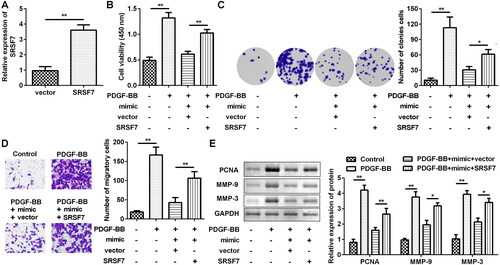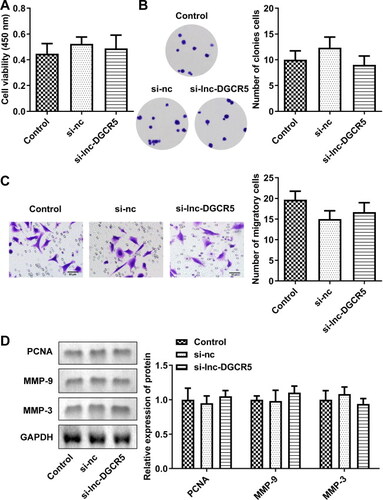Figures & data
Figure 1. Lnc-DGCR5 is up-regulated in ASMCs treated by PDGF-BB. (a) The expression level of lnc-DGCR5 increased in ASMCs treated with PGE2, ET-1, TGF-β1, and PDGF-BB. (b) The expression level of lnc-DGCR5 increased in PDGF-BB-treated ASMCs in a time-dependent manner. *p < 0.05 vs vehicle or 0 groups, **p < 0.01 vs vehicle or 0 groups.
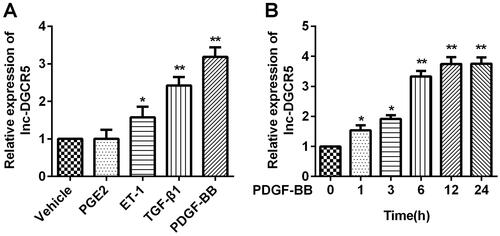
Figure 2. Lnc-DCR5 promotes the proliferation and migration of ASMCs. (a) Inhibiting the expression of lnc-DGCR5 was obtained through the siRNAs. (b) CCK-8 assay indicated that the cell viability of ASMCs treated by PDGF-BB is weakened when the expression of lnc-DGCR5 was inhibited. (c) Colony formation assay showed the significantly decreased proliferation ability of ASMCs when the expression of lnc-DGCR5 was inhibited. (d) Migrated ability of ASMCs, as observed using the Transwell assay, showed the migration of ASMCs after transfection. (e) Western blotting confirmed the effect of lnc-DGCR5 on PCNA, MMP-3, and MMP-9 expression in PDGF-BB-treated ASMCs. *p < 0.05, **p < 0.01.
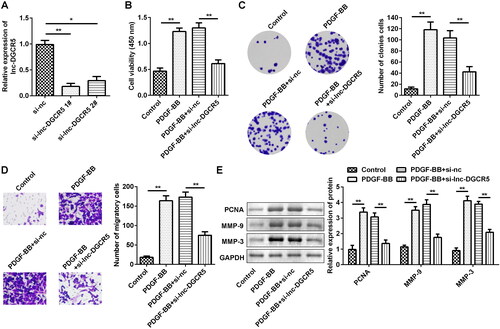
Figure 3. miR-204-5p acts as the target of lnc-DGCR5 in the ASMCs. (a) Bioinformatic analysis for the binding sites between miR-210-5p and lnc-DGCR5. (b) Luciferase assay was used to detect the direct interaction between miR-204-5p and lnc-DGCR5. (c) RNA pull-down assay confirmed that miR-204-5p can directly target lnc-DGCR5. (d) The expression level of miR-204-5p in the ASMCs was downregulated when lnc-DGCR5 was overexpressed, and its expression level was increased when lnc-DGCR5 was inhibited. (e) The expression level of miR-204-5p was downregulated in ASMCs treated by PDGF-BB, and knockdown of lnc-DGCR5 reversed the downregulation. **p < 0.01.
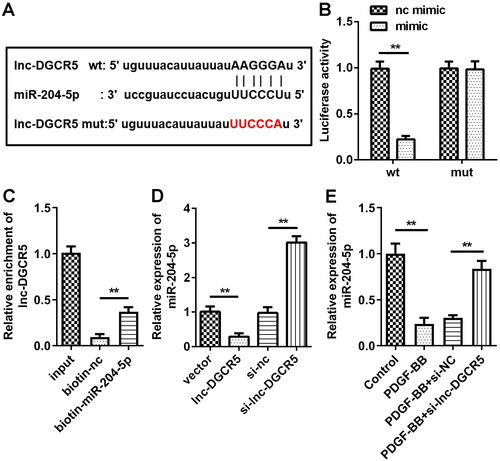
Figure 4. MiR-204-5p inhibition reversed the effect of lnc-DGCR5 knockdown. (a) The inhibitor can effectively inhibit the expression of miR-204-5p. (b) CCK-8 analysis showed that miR-204-5p inhibitor can rescue the cell viability in PDGF-BB-treated AMSC when lnc-DGCR5 was inhibited. (c) The results of the colony formation assay showed the miR-204-5p inhibitor can rescue proliferation ability in PDGF-BB-treated AMSC when lnc-DGCR5 was inhibited. (d) The results of the Transwell assay showed that the miR-204-5p inhibitor can rescue the migration ability of PDGF-BB-treated AMSCs when lnc-DGCR5 was inhibited. (e) Western blotting results showed that miR-204-5p inhibitor can rescue the expression level of PCNA, MMP-9, and MMP-3 in PDGF-BB-treated AMSCs when lnc-DGCR5 was inhibited. *p < 0.05, **p < 0.01.
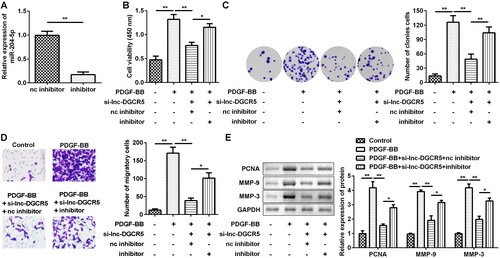
Figure 5. miR-204-5p targets SRSF7 directly. (a) The enrichment analysis of miR-204-5p targets-related biological pathway. (b) The binding site of miR-204-5p in SRSF7 3’-UTR. (c) The luciferase assay showed that miR-204-5p could directly targets SRSF7. (d) RNA pull-down assay confirmed that miR-204-5p can directly target SRSF7. (e) The expression level of SRSF7 in the ASMCs was downregulated when miR-204-5p was overexpressed, and its expression level increased when miR-204-5p was inhibited. (f) knockdown of lnc-DGCR5 decreased SRSF7 expression, and inhibition of miR-204-5p reversed the decrease. (g) The expression level of SRSF7 was upregulated in ASMCs treated by PDGF-BB. (h) Protein level of SRSF7 increased in ASMCs treated with PDGF-BB. **p < 0.01.

Figure 6. Overexpression of SRSF7 can rescue the proliferation and migration of ASMC treated by PDGF-BB, which is attenuated by overexpression of miR-204-5p. (a) qRT-PCR confirmed the overexpression efficiency of SRSF7. (b) CCK-8 analysis showed that overexpression of SRSF7 can rescue the cell viability in PDGF-BB-treated AMSC when miR-204-5p was overexpressed. (c) The results of the colony formation assay showed that overexpression of SRSF7 can rescue the proliferation ability in PDGF-BB-treated AMSC when miR-204-5p was overexpressed. (d) The results of Transwell assay showed that overexpression of SRSF7 can rescue migration ability in PDGF-BB-treated AMSC when miR-204-5p was overexpressed. (e) Western blotting showed that overexpression of SRSF7 can rescue the expression level of PCNA, MMP-9, and MMP-3 in PDGF-BB-treated AMSC when miR-204-5p was overexpressed. *p < 0.05, **p < 0.01.
